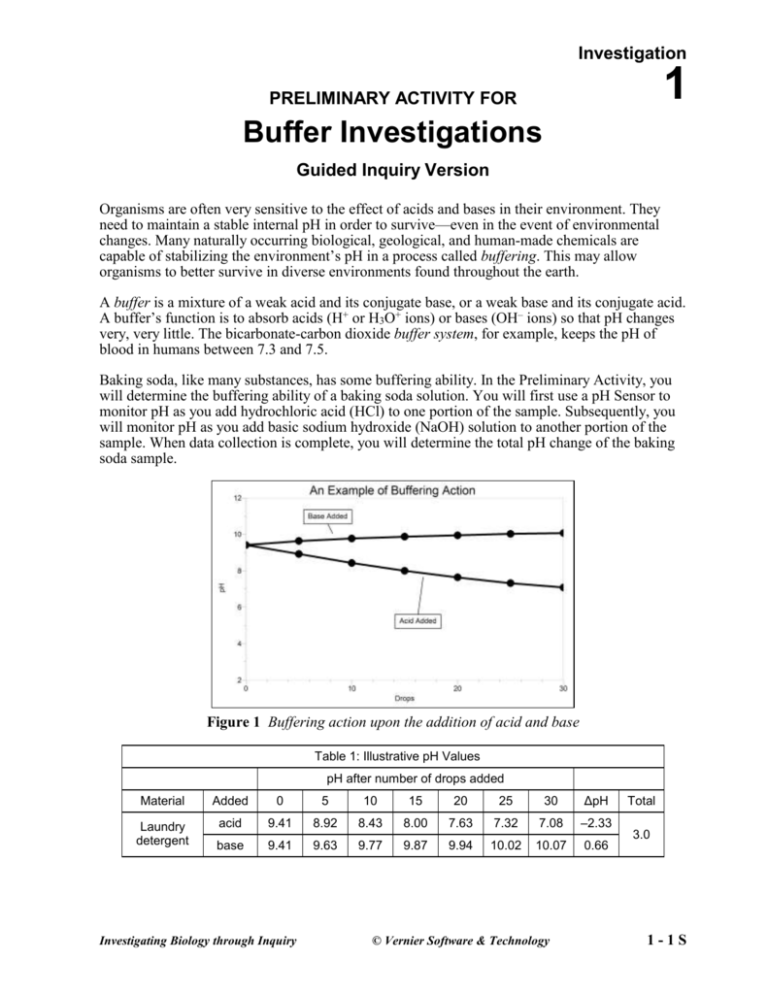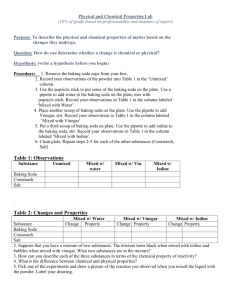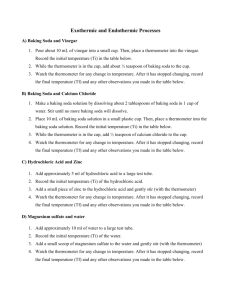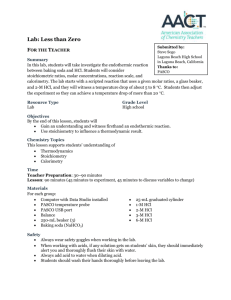02 Freeze Melt Water
advertisement

Investigation 1 PRELIMINARY ACTIVITY FOR Buffer Investigations Guided Inquiry Version Organisms are often very sensitive to the effect of acids and bases in their environment. They need to maintain a stable internal pH in order to survive—even in the event of environmental changes. Many naturally occurring biological, geological, and human-made chemicals are capable of stabilizing the environment’s pH in a process called buffering. This may allow organisms to better survive in diverse environments found throughout the earth. A buffer is a mixture of a weak acid and its conjugate base, or a weak base and its conjugate acid. A buffer’s function is to absorb acids (H+ or H3O+ ions) or bases (OH– ions) so that pH changes very, very little. The bicarbonate-carbon dioxide buffer system, for example, keeps the pH of blood in humans between 7.3 and 7.5. Baking soda, like many substances, has some buffering ability. In the Preliminary Activity, you will determine the buffering ability of a baking soda solution. You will first use a pH Sensor to monitor pH as you add hydrochloric acid (HCl) to one portion of the sample. Subsequently, you will monitor pH as you add basic sodium hydroxide (NaOH) solution to another portion of the sample. When data collection is complete, you will determine the total pH change of the baking soda sample. Figure 1 Buffering action upon the addition of acid and base Table 1: Illustrative pH Values pH after number of drops added Material Added 0 5 10 15 20 25 30 ΔpH Laundry detergent acid 9.41 8.92 8.43 8.00 7.63 7.32 7.08 –2.33 base 9.41 9.63 9.77 9.87 9.94 10.02 10.07 0.66 Investigating Biology through Inquiry © Vernier Software & Technology Total 3.0 1-1S Investigation 1 After completing the Preliminary Activity, you will investigate your assigned researchable question. Use reference sources to find out more about buffers and buffer systems before planning and conducting your investigation. PROCEDURE 1. Obtain and wear goggles. 2. Connect the pH Sensor to the data-collection interface. Start the data-collection program and choose New from the File menu. 3. Set up the data-collection software for the Events with Entry mode. 4. Use a utility clamp to fasten the pH Sensor to a ring stand as is shown in Figure 2. Testing the effect of acid on baking soda solution 5. Use a rinse bottle to thoroughly rinse the pH Sensor with distilled water. Important: Do not let the pH electrode dry out. Keep it in a 250 mL beaker with about 100 mL of tap water when not in use. The tip of the probe is made of glass—it is fragile. Handle with care! 6. Obtain a 20 mL portion of baking soda solution in a 50 mL beaker. Immerse the pH Sensor in the baking soda solution and swirl the beaker 7. Keep a data point for “0” drops of hydrochloric acid before any acid is added. 8. Add 5 drops of 0.10 M HCl to the baking soda solution. CAUTION: Handle this hydrochloric acid with care. It can cause painful burns if it comes into contact with skin, eyes, or clothing. 9. Swirl thoroughly. When the pH is stable, keep a data point for “5” drops of acid. 10. Repeat Steps 8 and 9, adding 5 drops at a time, until you have added a total of 30 drops of hydrochloric acid. 11. Stop data collection after you have added a total of 30 drops. 12. Record the pH values in your data table. Figure 2 13. Store this first run. Testing the effect of base on baking soda solution 14. Repeat Steps 5–12 substituting the base 0.10 M NaOH for the acid. CAUTION: Sodium hydroxide solution is caustic. Avoid spilling it on your skin or clothing. 15. Print graphs as directed by your instructor. 1-2S Investigating Biology through Inquiry Buffer Investigations QUESTIONS 1. Determine the total pH change of your baking soda sample. a. Determine the change of pH (ΔpH) upon the addition of acid. b. Determine the ΔpH upon the addition of base. c. Subtract the ΔpH for the acid from the ΔpH for the base to determine the total pH change. 2. Is a baking soda solution acidic, or is it basic? How can you tell which it is? 3. What was the effect of adding HCl? Why did this happen? 4. What was the effect of adding NaOH? Why did this happen? 5. List five materials whose buffering action might be interesting. 6. List two biological buffer systems. Investigating Biology through Inquiry 1-3S










